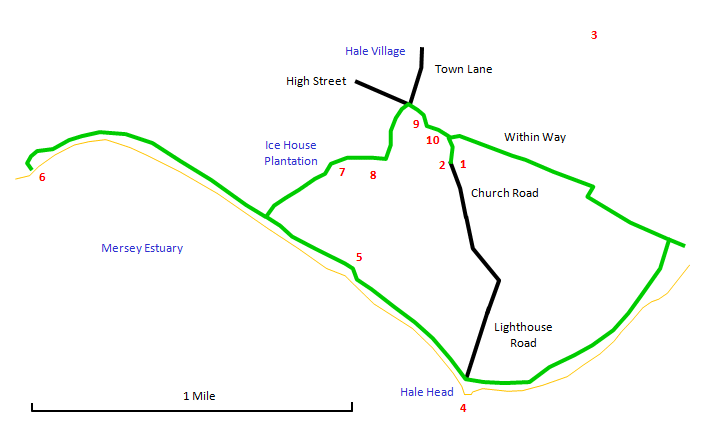| Around Hale | ||||
| Around Hale | ||||
This walk, taking in the historic village of Hale and the peaceful countryside between it and the Mersey estuary, is about 4½ miles (7½ km) in length. The route passes places of historical interest and there is a splendid feeling of space and isolation along the banks of the Mersey. Near the end you pass the Childe of Hale pub, where you can find the usual refreshments. The way is slightly rough in places and parts can be muddy, so walking boots are advisable. |
 |
Start in front of St. Mary's Church [1] on Church Road. The graveyard contains the tomb of local celebrity John Middleton, the Childe of Hale, easily spotted by being surrounded by railings. If you look up over his tomb back towards the road, you will see him carved life-size from a tree trunk [2]. |
Walk back towards the village along Church Road and turn right after a short distance onto Within Way. Follow the road, which eventually becomes a broad track. On the left about half a mile (1 km) away is the pentagonal tree and moat bounded Duck Decoy [3], originally built in the early 17th century to attract wild fowl for food and one of the few of its kind left in the UK. The track goes in a dog-leg following mediaeval field boundaries, with a view of the Widnes-Runcorn bridges to the left. It eventually goes through a gate, where it becomes narrower, and reaches the Mersey Way at a gate on the right not far from the river bank. You can walk right down to the river, though it is often marshy. It is an exhilarating place to be at high tides with the vast expanse of water lapping at your feet. |
Take the Mersey Way on the right and follow the river bank until you reach the disused lighthouse [4] at Hale Head. Built on the site of an earlier lighthouse dating from 1838, this one was completed in 1907; it is now a private residence. This is a wonderfully isolated spot, with views across the water to the Frodsham and Helsby Hills. There are sandstone outcrops and a small sandy beach, a pleasant place to linger. Continue ahead along the Mersey Way, crossing a bridge over the Lady Pool brook [5], where a long strip of woodland, the Icehouse Plantation, lies along the horizon ahead. Keep on going until you reach a gate where the plantation meets the river bank. |
Go straight past the Icehouse Plantation and the path gradually rises to Hale Cliff. Eventually you reach a hedge belonging to a house on the right. Go down the steps on the left here, cross a little brook and ascend the rather steep steps on the other side to regain the crest of Hale Cliff. At the end of Hale Cliff, the path broadens and descends. Bear round to the left and you reach a little plateau at sea level called The Dungeon [6]. Here there is an old sandstone quay, but the remains of a late 17th century salt refinery that stood here until a few years ago have disappeared. This historic site is a green and peaceful spot. Retrace your steps to the gate by the Icehouse Plantation. |
Turn left at the gate to enter the Icehouse Plantation. After a short while you pass two ponds on the left. By the second of these, you will see a little mound on the right with a bricked up entrance behind. This is the eponymous ice house [7], used for the underground storage of ice from the ponds for nearby Hale Hall [8] (main building demolished) and possibly dating from 1806. Keep straight ahead where a farm track crosses and, with Hale Hall (no access) on the right, turn left onto a broad track with a playing field on its left. Follow this to exit into Hale High Street opposite the post office. Go right into Church End, where the Childe of Hale pub [9] is conveniently situated. Just past the pub on the right is a thatched cottage [10], where John Middleton is thought to have lived. A little further on is your starting point. |